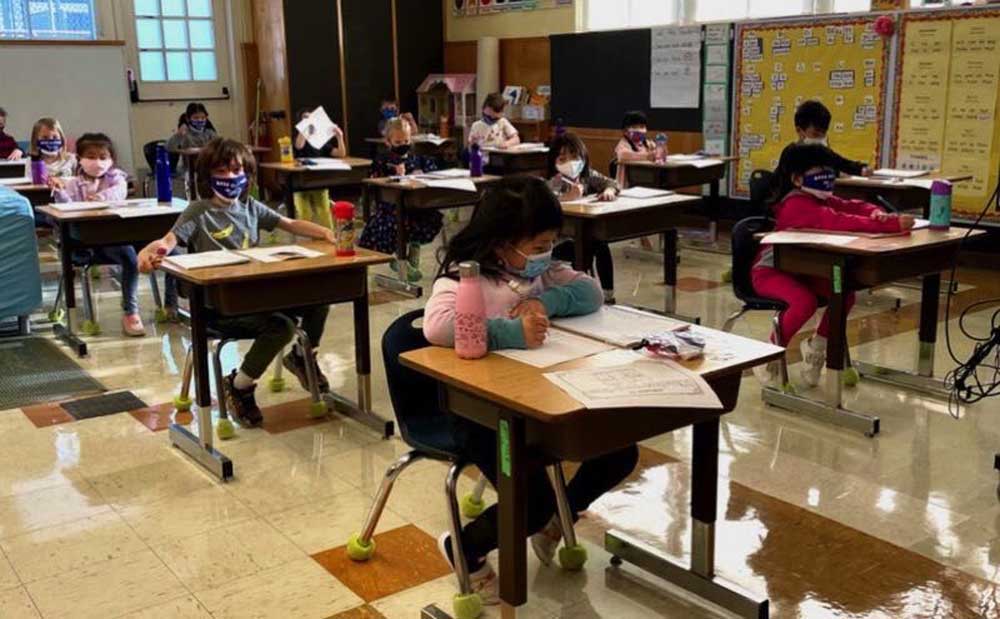OPINION: Arrogance and insult will hardly improve our schools
Published 5:00 am Saturday, March 1, 2025

- Rose City Park Elementary first graders who returned to the classroom for the first day of hybrid learning during the pandemic. A columnist argues that student-success metrics are incorrect.
I’ve spent far more time in public school classrooms than Tim Nesbitt. What he knows about teaching and intelligent school reform can fit comfortably in a thimble. His recent piece on Oregon test scores offers little of value (“Better grad rates but worse test scores befuddle lawmakers, validate reformers”, Feb. 19).
Trending
Nesbitt treats the original Oregonian report as helpful. It is not. It claims the “Nation’s Report Card” scores are “scrutinized from coast to coast for any sign that students were recovering from pandemic setbacks.” Wrong. Testing experts do NOT view these scores as definitive, and they routinely caution against drawing firm conclusions from them. Yet the reporter found a professor from Washington D.C. who, based on test scores alone, saw fit to opine that “Something has to change in Oregon schools.”
The same “scholar” also told the Oregonian that “Students’ eighth grade math scores … are a predictor of the state’s future economy.” This is a wild exaggeration unsupported by the evidence and refuted years ago by serious educational historians.
Under the deeply flawed No Child Left Behind law, each state had a unique definition of “proficient” on test scores. So there was pressure to find a common yardstick for comparing the states. It already existed: the National Assessment of Educational Progress, which had its own definition of “proficient.” Unwisely, the U.S. Dept of Education sought for years to use the discrepancy between NAEP and state test results to shame the states into better performance.
Trending
NAEP achievement levels are absurdly high. A decade ago, by international standards, American fourth graders were well above average in math and third in the world in science. Yet only a third of them showed up as proficient on NAEP math and science tests. Kids who are virtually on top of the world are not proficient? It makes no sense. NAEP standards then and today ensure that no one will ever attain a 100% proficiency for any group.
Why would anyone foist such a no-win system of evaluation on our public schools? Nesbitt can’t be bothered with such questions, preferring instead to chastise educators and lawmakers for making “excuses.” But his own record in policymaking deserves scrutiny here.
Nesbitt advised two governors who supported legislation that did real and long-term harm to the teaching profession and to our schools. Ted Kulongoski publicly promised (in my presence) that he would never support cutting the pensions of school employees. A month later he came out in favor of a PERS “reform” bill which did precisely that.
Nesbitt implies that “new high-energy teachers” will make a big difference in school performance today. Yet both of his bosses in Salem adopted policies that discourage such people from entering or staying in the teaching profession. John Kitzhaber supported a bad charter school bill that allowed up to 50% of a school’s teachers to work without any professional license at all. In 2012 Kitzhaber convened an “emergency” session of the Legislature for the sole purpose of extending major tax breaks for Nike for another 25 years. No one explained how schools would replace the loss of funding that this tax relief entailed.
Let’s review, then: It’s well known that teachers’ salaries are mediocre compared to those of comparable professionals. It’s also true that school employee benefits in Oregon (health insurance and retirement) have suffered multiple cuts in this century, and that workloads (e.g., class size) remain unmanageable. Given these disincentives, what does Nesbitt think will attract and retain first-rate people to teach our kids? Instead of insight, he relies on a medieval approach to motivation: using NAEP test scores as a cudgel against educators and their advocates.
Nesbitt wants to press for a “compelling and reasonable response” to the NAEP “report cards” of the past decade. His plea is misguided insofar as it assumes that new or relevant insights will come from the NAEP data. Remarkably, there’s no hint that he has listened to what classroom teachers think would be “a clear-eyed prescription for what to do next.” And he insults professionals by suggesting that no one before now has ever tried “regularized tutoring and ongoing summer school programs.”
The nonprofits that Nesbitt praises are run by well-meaning people whose support is valuable. But their expertise in improving teaching and learning is quite limited. The truth is, we can devise a worthy agenda for school reform without seeking guidance from NAEP scores at all.
First, let’s get serious about eliminating child poverty in Oregon. Nothing has a greater impact on student achievement. This will require more spending and tax reform. Anyone up for that in Salem?
Second, let’s strengthen, not undermine, the collective bargaining rights of school employees. A good start would be to pass SB 916 in Salem. Reform will never succeed if it rests on squeezing more sacrifices out of school employees.
Third, provide more time for teachers’ professional development and for in-school collaboration with colleagues. This too will cost money.
Last, cultivate local and regional experts in curriculum and instruction. Professors who have not taught in recent years, and pundits who lack any real understanding of local needs, will provide little of value in this effort.
Why would anyone foist such a no-win system of evaluation on our public schools?







